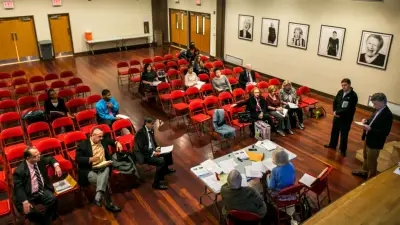Opinion: The Promise—and Pushback—on NYC’s Racial Impact Studies

Racial impact studies don t block or delay rezonings They only pull together records that s already publicly available the authors write What the backlash reveals is how uncomfortable particular developers are with giving communities the tools to demand more from a broken status quo A Manhattan society board meeting in The authors are calling for better trainings for boards across the city around how to evaluate racial impact studies when weighing in on new advancement proposals Photo by Adi Talwar When New Yorkers hear plans of a new evolution or rezoning in their neighborhoods residents invariably ask the same question Will it drive up rents Will longtime residents especially communities of color get pushed out For decades there was no requirement for the city to provide information to directly answer those questions That changed in after years of organizing by housing justice advocates like the Racial Impact Scrutiny Coalition RISC when New York created new tools to confront the racial impacts of land use decisions Racial impact studies more formally known as Racial Equity Reports RER are now mandated for inclusion in certain land use applications to show a project s prospective effects on local housing affordability displacement threat and job access General information tools managed by city agencies were also created to help residents and decision-makers understand neighborhood trends and where displacement jeopardy is highest These tools marked a milestone in the city s zoning history But nearly four years later a new assessment from the Pratt Center finds that these tools are being underused and under-supported putting their promise at threat Making the Most of Out of Racial Equity Reports analyzed over RERs and interviewed group board members and elected authorities The findings are clear multiple boards have received no training and certain have not even heard of the tools Applicants often fail to present racial impact studies during society review And for a large number of residents parsing the material remains confusing and inaccessible due to lack of training In this vacuum particular opponents are seizing the opportunity to discredit the rule entirely Earlier this year an op-ed in The Real Deal went so far as to call racial impact studies apartment killers That framing is not only false it s dangerous Racial impact studies don t block or delay rezonings They solely pull together facts that s already publicly available Developers can prepare the statement themselves but a large number of hire consultants a cost of just a limited thousand dollars for projects worth millions What the backlash reveals is how uncomfortable specific developers are with giving communities the tools to demand more from a broken status quo Let s be clear RERs aren t what s holding back housing production Neither is area input New York s housing challenges are complex shaped by decades of program decisions sector forces and systemic inequities But instead of grappling with those underlying issues specific newest conversations have focused on cutting back general review to speed up approvals as seen in the mayor s Charter Revision Commission hearings This push on the society review process is happening right alongside broader efforts by the city to accelerate new housing growth and change is coming fast That s a risky tradeoff If we re serious about equitable improvement we should be strengthening our anti-displacement tools not sidelining them from the conversation That means making sure these tools truly work for the people they were meant to serve It starts with training locality board members something the city still hasn t done on how to use RERs It means improving the existing statistics tools to make it easier for residents to deal with And it requires holding developers accountable for presenting their RERs as part of general review for discussion not just submitting them as a technicality These are exactly the moments when communities need clear accessible and well-supported tools to shape enhancement before it reshapes them But tools are only as useful as the stake we make in their implementation These reports were never meant to sit on a shelf They were meant to inform decisions start conversations and empower local advocacy That only happens if we give communities the guidance to use them No tool is perfect RERs won t solve our housing situation alone But they represent a meaningful step toward transparency and a foundation for accountability in a land use system that has too often overlooked racial impact District members fought hard to win these tools and the city took an crucial first step by creating them Now the challenge is to ensure they re used effectively with the training visibility and promotion needed to meet their full promising Tara Duvivier is a senior planner at the Pratt Center for Area Rise Eve Baron is the chairperson of Pratt Institute s Graduate Center for Planning and the Setting in the School of Architecture The post Opinion The Promise and Pushback on NYC s Racial Impact Studies appeared first on City Limits


